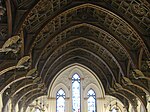Charlestown, Boston

Charlestown is the oldest neighborhood in Boston, Massachusetts, in the United States. Originally called Mishawum by the Massachusett tribe, it is located on a peninsula north of the Charles River, across from downtown Boston, and also adjoins the Mystic River and Boston Harbor waterways. Charlestown was laid out in 1629 by engineer Thomas Graves, one of its earliest settlers, in the reign of Charles I of England. It was originally a separate town and the first capital of the Massachusetts Bay Colony. Charlestown became a city in 1848 and was annexed by Boston on January 5, 1874. With that, it also switched from Middlesex County, to which it had belonged since 1643, to Suffolk County. It has had a substantial Irish-American population since the migration of Irish people during the Great Irish Famine of the 1840s. Since the late 1980s, the neighborhood has changed dramatically because of its proximity to downtown and its colonial architecture. A mix of yuppie and upper-middle-class gentrification has influenced much of the area, as it has in many of Boston's neighborhoods, but Charlestown still maintains a strong Irish-American population. In the 21st century, Charlestown's diversity has expanded dramatically, along with growing rates of the very poor and very wealthy. Today Charlestown is a largely residential neighborhood, with much housing near the waterfront, overlooking the Boston skyline. Charlestown is home to many historic sites, hospitals and organizations, with access from the Orange Line Sullivan Square or Community College stops or the I-93 expressway.
Excerpt from the Wikipedia article Charlestown, Boston (License: CC BY-SA 3.0, Authors, Images).Charlestown, Boston
Austin Street, Boston Charlestown
Geographical coordinates (GPS) Address Nearby Places Show on map
Geographical coordinates (GPS)
| Latitude | Longitude |
|---|---|
| N 42.375277777778 ° | E -71.064444444444 ° |
Address
Austin Street 8
02129 Boston, Charlestown
Massachusetts, United States
Open on Google Maps








